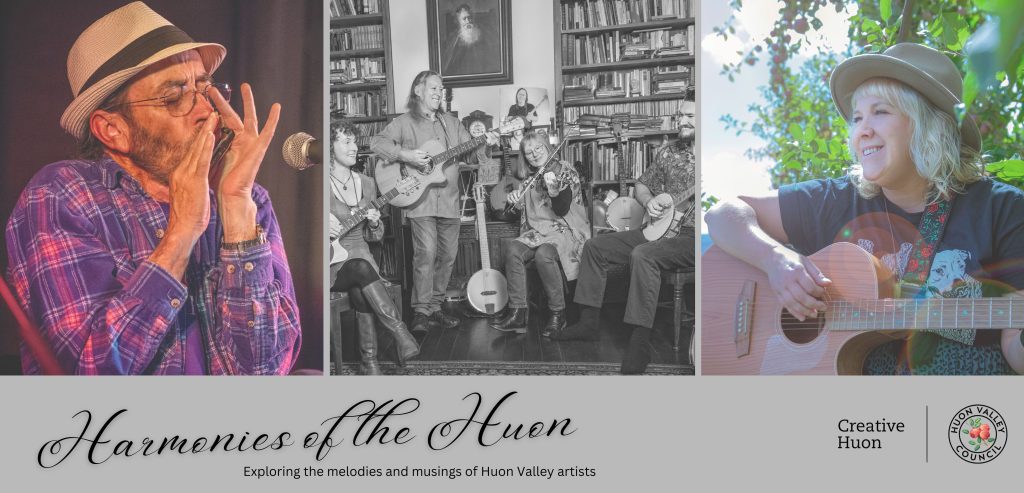When I visited musicians and historians Steve and Marjorie Gadd’s house in Franklin, I found instruments and sheet music scattered in nearly every room.
‘This looks promising’, I think. ‘Tell me about the Huon Valley’s musical history.’
Steve explains that in the early years in the Huon, there wasn’t much entertainment, so the dances were everything. They were the places where young people met.
‘The apple industry boomed and many apple sheds were built,’ he says. ‘After the harvest during those long, warm days in late summer, the sheds were empty. They’d push all the benches back, treat the floor with talcum powder or wax and dress the halls with colourful ribbons and flowers and one street or valley would host the apple shed dance.’
The popular dances were quadrilles or set dances, the ancestors of American square dances and Australian bush dances. There were also reels and jigs, with Scottish and Irish influences.
The bands would try to work out what songs they could include in their shed dance repertoire.
Local musicians would play melodeons which were button accordions. An upright piano might come in a truck from someone’s living room, and there would be a few fiddles. Soon the musicians were creating new tunes as they compromised and invented, fitting in with the fixed-key accordions.
‘This process was an incubator for new tunes,’ Steve says. ‘Regional towns around Tasmania developed distinctive styles and variations of tunes. Most musicians couldn’t read music, so a tune would move around the state and evolve into another tune with local deviations.’
In the 1920s, couple dances were introduced – foxtrots, waltzes, polkas, the mazurka in 3/4 time and the schottische, a slow polka with hops in the steps.
‘You could have Roaring 20s tunes played in the same set as trad 1870s tunes, which must have been quite amazing,’ Steve says.
Set dances continued to be popular – quadrilles, the Lances and Alberts. These would start with dancers taking the hand of the couple opposite, marching around the hall, then moving into a jig, polka or waltz.
‘These evolved into what we now know as bush dances, which are simplified versions of these older styles,’ Steve says.
Most towns had brass bands, which played standard tunes and also included a cosmopolitan repertoire using sheet music from England and America. These were the early stages of jazz and English dance music. There were a couple of brass bands in Cygnet and one in Geeveston.
‘These bands would still play the old apple shed tunes for the older people,’ Steve says. ‘Then for the younger dancers they’d play the latest numbers from the USA. The music was very jumbled up and eclectic.’
In the 1960s the local Council began hosting grand balls at the Palais and Cygnet halls. Radio reception improved and young people were hearing Bill Haley and Elvis, and new styles of popular music from America, so they moved away from the older music.
‘The older generation put their instruments down and would sit around listening to 78 records,’ Steve says. ‘But their music wasn’t forgotten and the names of the early Huon musicians are preserved in the song names – Uncle Charley’s Waltz, Tiger Piling’s Waltz, Sid Macham’s Schottische, Lionel Phillips’ Mazurka.
In the 1990s, Steve was fortunate to find some of these early Huon musical pioneers and record them on tape. Some were 85 years old and still playing.
Interestingly there was no recorded local folk music until the American Burl Ives came to Australia and produced an album of Australian folk songs.
‘In the 1960s and 1970s, a folk revival youth movement arrived in the Huon, bringing a renewed interest in folk music.’
The first folk club opened in Hobart in 1958 at Hobart College and then a year later at Tas Uni. In 1976 the Franklin Folk Club was established, but there wasn’t a true regional music festival in the Huon until the highly-successful Cygnet Folk Festival arrived on the scene in May 1982.
‘Our passion is to keep traditional Tasmanian music alive,’ Steve says. ‘So, our house often hosts up to 15 players, with their guitars, tin whistles, melodeons, banjos, accordions, mandolins and fiddles.’
Steve and Marjorie have authored several books on Tasmanian folk tunes and co-founded the Tasmanian Heritage Fiddle Ensemble. Steve’s latest publication, The Gentle Care For Broken Things, weaves a captivating narrative spanning 300 years, tracing the journey of a violin from Europe to Tasmania and the impact it has on the lives and musicians it encounters through time.
‘Harmonies of the Huon: Exploring the melodies and musings of Huon Valley artists‘ is a Creative Huon series in collaboration with Huon Valley Council and Huon Valley Tas, showcasing the Huon Valley’s musical talents, their inspiration and journeys.

